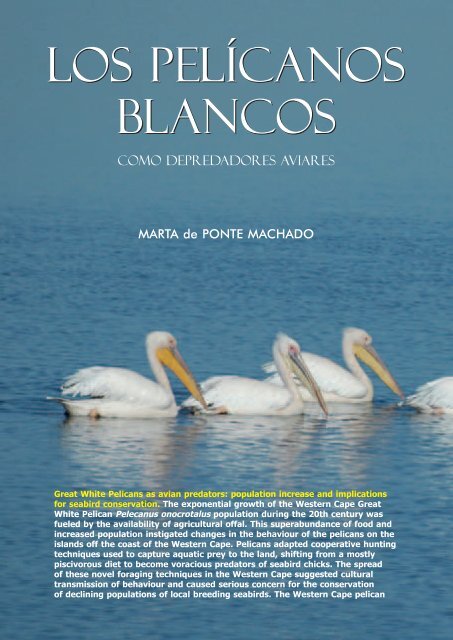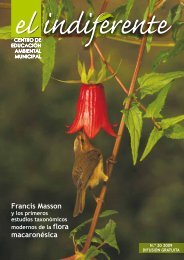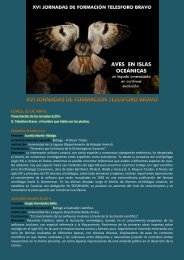El Indiferente - Villa de La Orotava
El Indiferente - Villa de La Orotava
El Indiferente - Villa de La Orotava
You also want an ePaper? Increase the reach of your titles
YUMPU automatically turns print PDFs into web optimized ePapers that Google loves.
42<br />
Los peLícanos<br />
b<strong>La</strong>ncos<br />
como <strong>de</strong>predadores aviares<br />
MARTA <strong>de</strong> PONTE MAChAdO<br />
Great White Pelicans as avian predators: population increase and implications<br />
for seabird conservation. The exponential growth of the Western Cape Great<br />
White Pelican Pelecanus onocrotalus population during the 20th century was<br />
fueled by the availability of agricultural offal. This superabundance of food and<br />
increased population instigated changes in the behaviour of the pelicans on the<br />
islands off the coast of the Western Cape. Pelicans adapted cooperative hunting<br />
techniques used to capture aquatic prey to the land, shifting from a mostly<br />
piscivorous diet to become voracious predators of seabird chicks. The spread<br />
of these novel foraging techniques in the Western Cape suggested cultural<br />
transmission of behaviour and caused serious concern for the conservation<br />
of <strong>de</strong>clining populations of local breeding seabirds. The Western Cape pelican<br />
<strong>El</strong> <strong>Indiferente</strong> | 21 MARZO 2011 MARZO 2011 21 | <strong>El</strong> <strong>Indiferente</strong><br />
population was found to be genetically less variable than other southern African<br />
breeding colonies. However, pelicans from the Western Cape dispersed and<br />
some individuals entered into contact with pelicans further north, indicating that<br />
cooperative seabird-eating behaviour could be exported to other populations.<br />
With the aim of curbing the impact of pelican predation on seabird populations,<br />
a management intervention, consisting on chasing pelicans from selected seabird<br />
colonies, was implemented on two islands of the West Coast National Park and<br />
proved successful to reduce predation and to protect vulnerable colonies of<br />
seabirds.<br />
43






